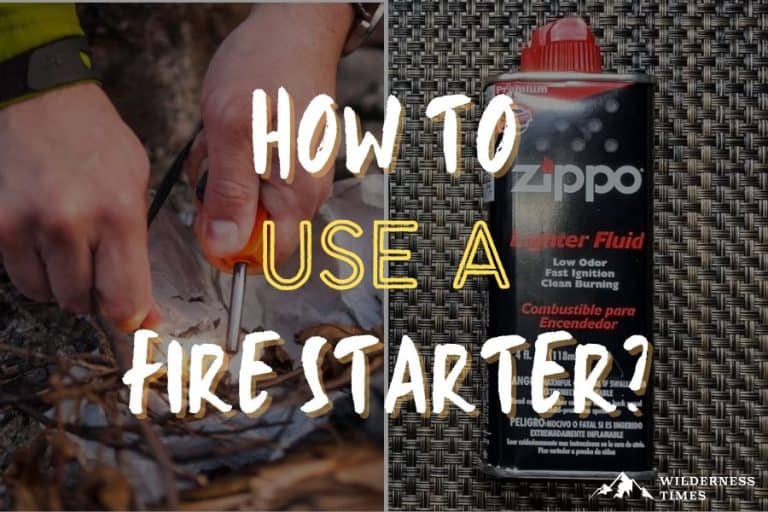Whether it’s a magnesium alloy or ferrocerium firesteel, a fire starter is a great way to get your campfire going in no time.
That means more relaxation time, chilling by the campfire roasting marshmallows for s’mores.
Don’t know how to use a fire starter? You’ve come to the right place.
Here’s a step-by-step guide with all the information you need, plus some handy tips and tricks:
Using A Fire Starter: A 6 Step Guide
Step 1: Prepare Your Fire Pit
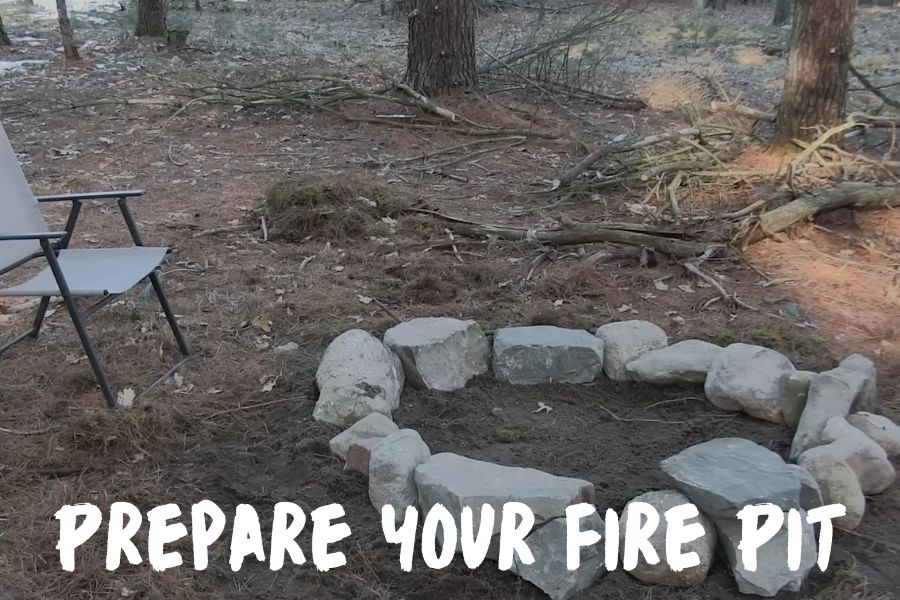
Before you can get started, the first thing you have to do is get your fire pit ready.
- If you’re making your own fire pit rather than using a designated fire pit, you need to find a suitable area to build one. Try to find a nice, flat spot. If it’s windy, try to find a natural windbreak, like a row of trees, and build your fire where there isn’t too much wind.
- Next, decide on which kind of fire pit you’re building and build it. There are 2 main methods you can go for:
- Dugout: for a dugout fire pit, dig a hole in the ground.
- Mound: for a mound fire pit, build a mound on the ground out of sand or dirt.
- Whichever kind you go for, make sure to build it a bit larger than you want your fire. This minimizes risk by making it easier to contain the fire.
- Don’t forget to clear the area around your fire pit of any dry vegetation and anything else on the ground that can catch fire.
Step 2: Gather The Firewood
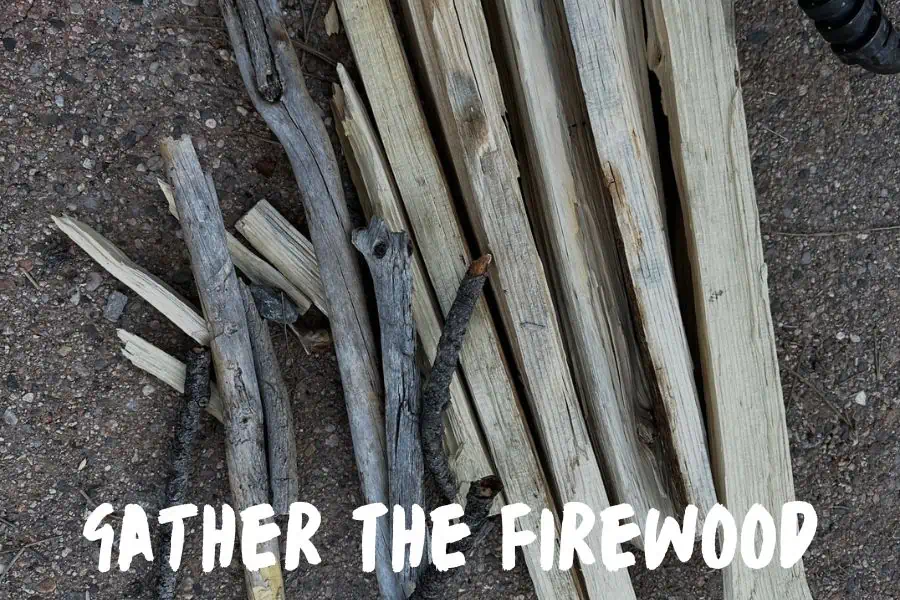
Make sure you’ve got plenty of firewood ready to go, so that when your fire gets going you’re ready to feed and maintain it.
You’re going to need wood in 3 different sizes:
- Tinder: small twigs or shavings or shreds of wood that ignite easily. This is used to get your fire going, and you need as much of it as possible to begin with. You can also use things like dry grass, newspaper, egg carton or cotton wool as tinder.
- Kindling: larger twigs and smaller chunks of wood. Once your tinder is alight, it can begin to burn your kindling. The fire will then be strong enough to burn larger pieces of wood (you can also split larger logs into kindling using a hatchet).
- Large chunks of wood: the fuel that keeps your fire going. These burn slowly, so once they’re on your fire will stay alive for a while.
Your firewood should be as dry as possible. Wood that isn’t dry enough won’t burn well.
Pro tip: if the wood you’re using could be dryer, place it around the fire while it’s burning, so it’ll have time to dry before you throw it on. Dry tinder is essential to begin with, of course, so if you haven’t got any use another flammable material. See Best Wood for a Campfire.
Step 3: Strike The Flint
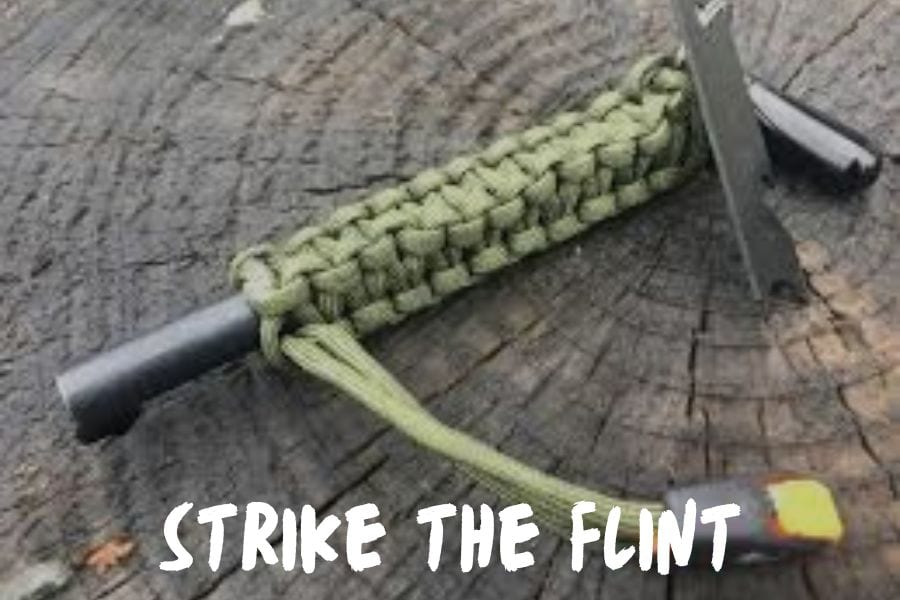
This is where your fire starter comes into the equation.
- A fire starter consists of 2 parts: a block or rod with a flint strip and a blade. If you’ve only got 1 part, use a knife as your blade.
- If you’re using a magnesium fire starter, scrape some shavings off the rod over your fire pit.
Note: If you’re not sure how much magnesium you need, start with a smaller amount. If it isn’t enough to get your fire going, add some more. Magnesium is dangerously flammable, so you don’t want too many shavings, or you might burn your eyebrows off when you ignite it.
- Strike the flint strip with your blade to produce sparks. Strike it in a similar way to how you would strike a match. That is, drag the blade across the flint strip.
Pro tip: rather than holding the block or rod in one hand and striking it with your blade, try holding the blade steady while you use the fire starter to strike it. This is a good way to avoid any accidents with your knife.
- The force, speed and angle you use will determine how many sparks you get. If you’re not having any success, try adjusting one of these factors.
- When your tinder (and magnesium shavings) comes into contact with the hot spark, it’ll begin to burn.
Step 4: Blow To Get The Fire Going
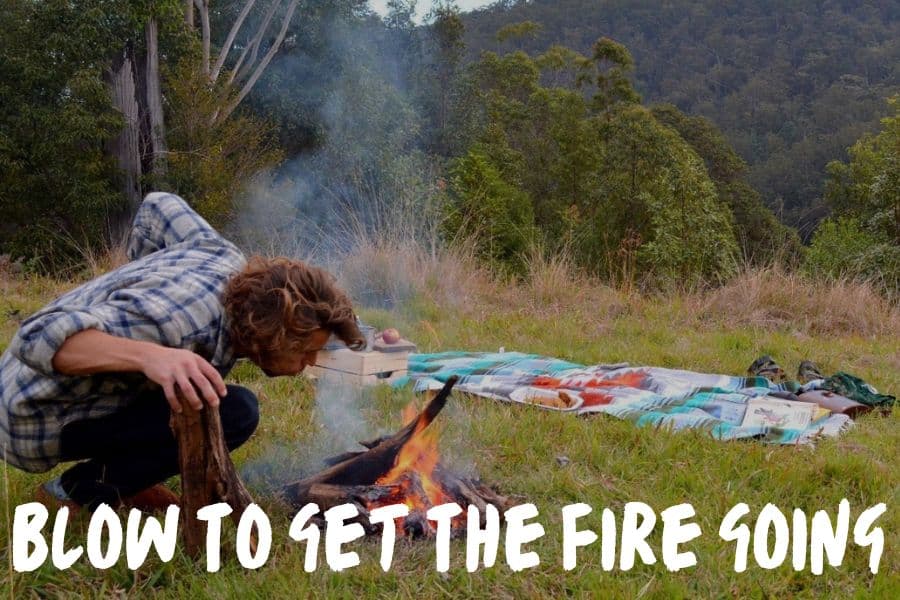
You might have already managed to ignite a flame in step 3. If so, good job! If not, here’s what to do.
- Gently blow on the tinder, which should be smoking and smoldering by now at the very least.
- Providing the right amount of oxygen will ignite the embers into flames.
Step 5: Keep The Fire Going

Now that your fire is up and running, all you have left to worry about is keeping it going, and the marshmallow to chocolate ratio in your s’mores.
- To maintain your fire, add large pieces of wood as needed.
- Always make sure to keep an eye on your fire while it’s burning, to ensure it doesn’t spread.
Step 6: Extinguish The Fire
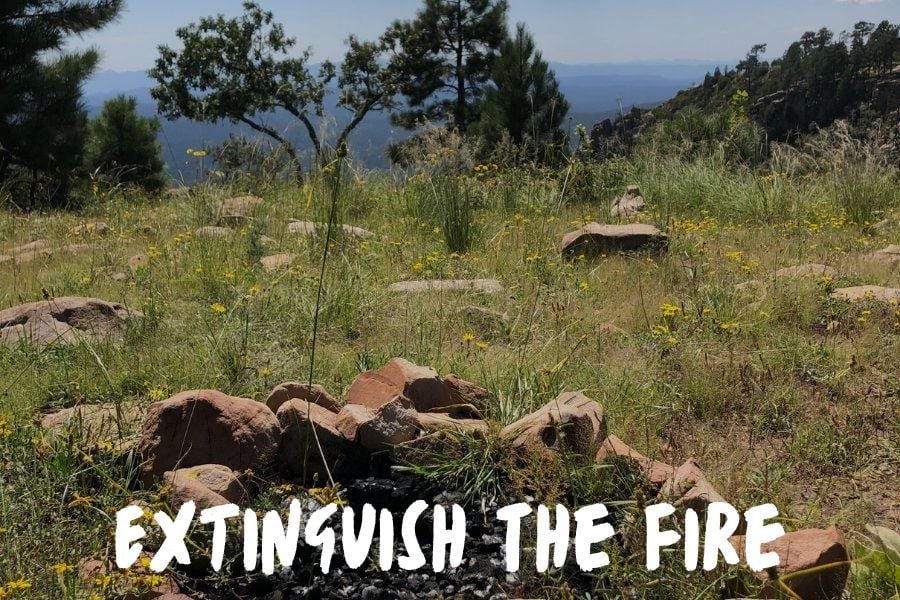
Make absolutely sure you’ve put your fire out properly before leaving the site. This is very important.
It might look like it’s extinguished, but still be burning underneath.
To prevent accidental fires, always double-check to make sure you’ve done a good job.
- To extinguish the fire, throw a generous amount of water over the fire pit.
- Stir the coals to make sure there aren’t any at the bottom that are still lit.
- Although many people claim that you can also use dirt instead of water, the reality of the situation is that it doesn’t work nearly as well. Coals at the bottom of the fire pit can easily remain hot enough to reignite, so always use water to be safe.
Read: How to Put Out a Fire Pit
Types of Fire Starters
Friction-Based Fire Starters
One of the most ancient ways to make fire is by using friction to create heat and, with enough effort, sparks that can be built up into a fire.
The following methods primarily use fiction to create fires.
While it is much more difficult to start a fire with friction-based fire starters in wet weather conditions, it is not impossible.
Hand Drill
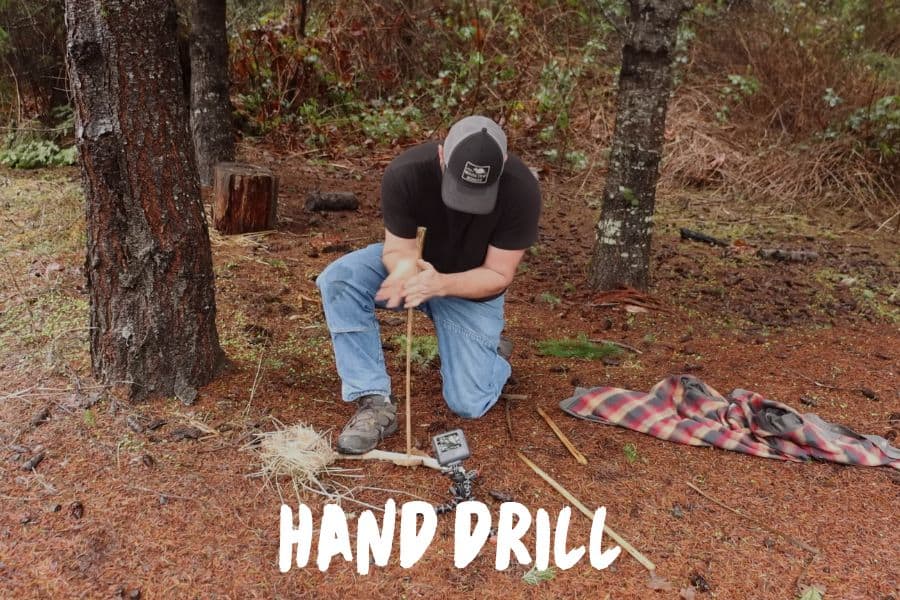
Perhaps the simplest way to create a friction fire, the hand drill technique involves two main objects – a dull rod and a long flat piece of wood.
Users will set up the rod perpendicularly to the long piece of wood and spin the rod between their hands so that the rod’s narrow end is making contact with the other piece of wood.
With enough pressure and movement (friction), the place where the two pieces of wood make contact will begin to heat up.
Many users will place lightweight kindling near the contact point so that it will catch any escaping sparks that are created in the process.
Bow Drill
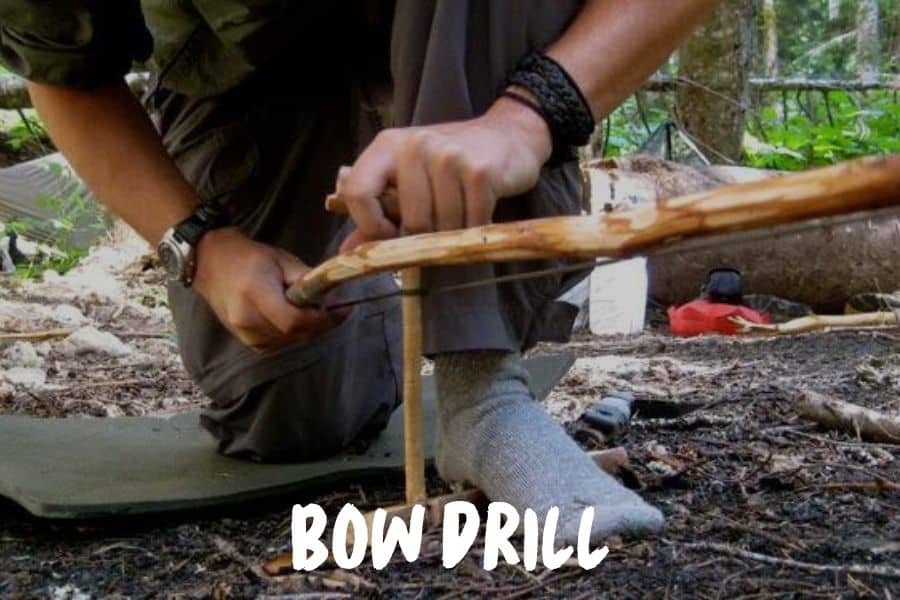
The bow drill is a slightly more complicated version of the hand drill technique.
In addition to the two pieces of wood, this technique also uses a “bow” – very similar to a bow and arrow.
In this case, the string on the bow is wrapped around the rod, making it even easier for the user to spin the rod in one place.
Check out the video below to learn more about the bow drill technique.
Fire Plough
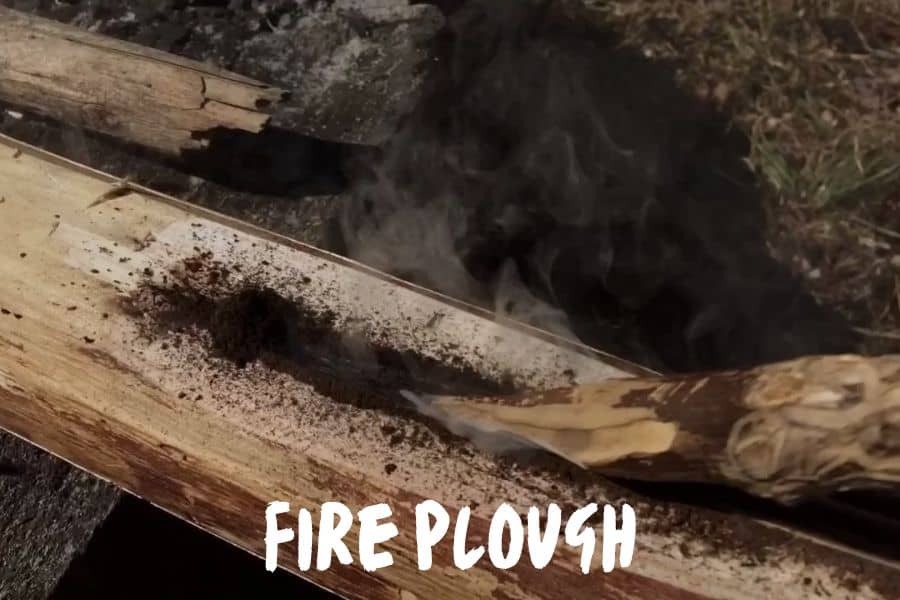
The fire plough technique involves using one piece of smaller wood to carve out a “plough,” or long narrow groove, in a larger piece of wood, creating friction and heat in the process.
One of the things that’s great about this method is that the motion carves out small pieces of wood to create the groove, creating kindling for the sparks to catch.
While this method can be slightly difficult to learn, it’s a great technique to have in your backpocket – and can be done almost anywhere.
Spark-Based Fire Starters
Spark-based fire starters can be a great addition to any camper’s gear pile.
Not only are they durable and lightweight, they can also be used in any weather conditions and are not negatively affected by moisture.
Flint & Steel
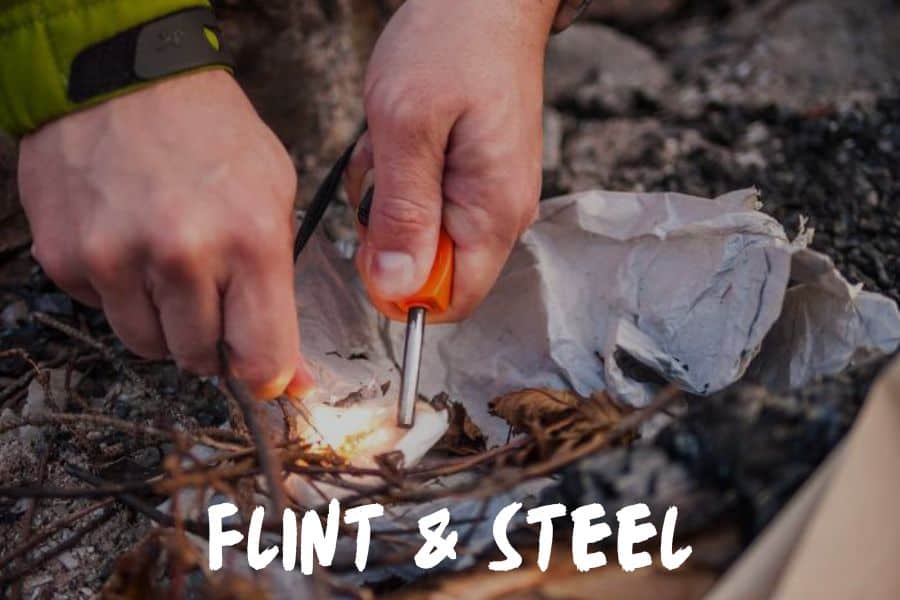
Another ancient method, flint and steel have been used in combination for millennia to create and build fires.
Flint, an extremely durable rock, is able to break off pieces of steel, a natural metal.
When the steel particles come into contact with the oxygen in the air, they are likely to ignite spontaneously, creating sparks.
This method is fairly straightforward. To create sparks, users will hold the flint so that it’s facing down towards a pile of tinder on the ground.
Then, they will run the steel over the flint and down towards the pile of tinder.
The idea is that gravity will force the sparks created by the steel to fall towards the tinder, creating an eventual flame.
Ferrocerium Rods (“Ferro Rods”)
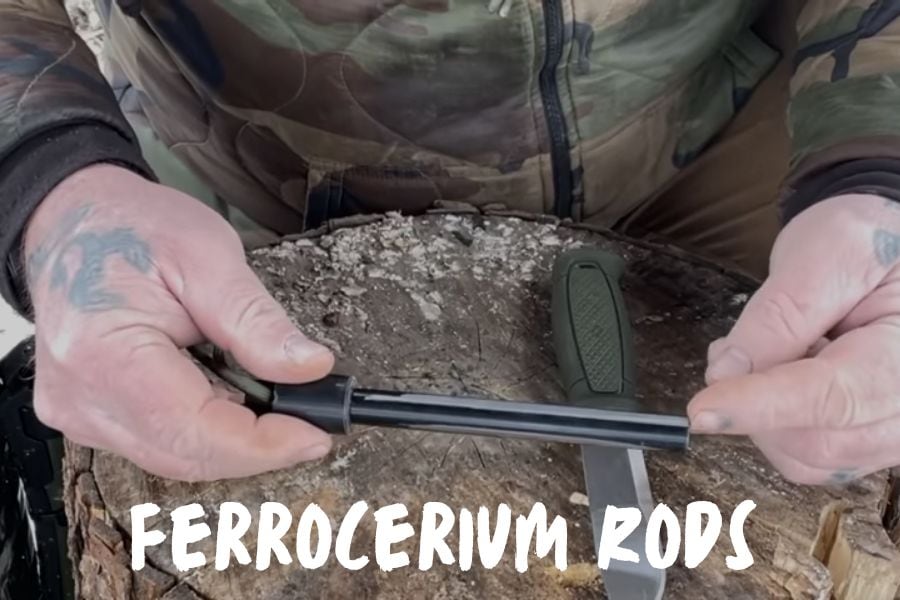
The more modern twist to flint and steel, ferrocerium rods (more commonly known as “ferro rods” or “firesteel”) use a combination of metals to make starting fires even easier.
In this method, the flint is replaced by a metal alloy rod containing flammable metals, including iron, magnesium, lanthanum, and cerium, which can be scraped off to form a small spark-catching pile.
Once a small pile of metal scrapings is created, users will run the steel over the metal rod to create sparks.
When the sparks hit the small pile of metal, they will catch and give the user opportunity to add tinder and other kindling.
The best part about this method is that, when compared to other techniques, it generally buys the user a few more moments to get the fire going.
While similar in style, users may also find firesteel tools that are made purely of magnesium, rather than of the alloy listed in ferro rods.
Magnesium rods will also work well but will generally create less sparks than the metal alloy rod.
Chemical Fire Starters
Chemical fire starters are great for car camping scenarios because they are slightly less reliable, and in some cases, more cumbersome to carry.
In comparison, friction and spark-based fire starters can be used in all camping scenarios but are especially great for long distance treks and survival camping.
It should also be noted that chemical fire starting methods leverage chemicals to create fire and are less environmentally friendly than other options.
Using a chemical firestarter will involve incorporating chemicals into the fire, and ultimately, the air around you.
Firestarter Tablets
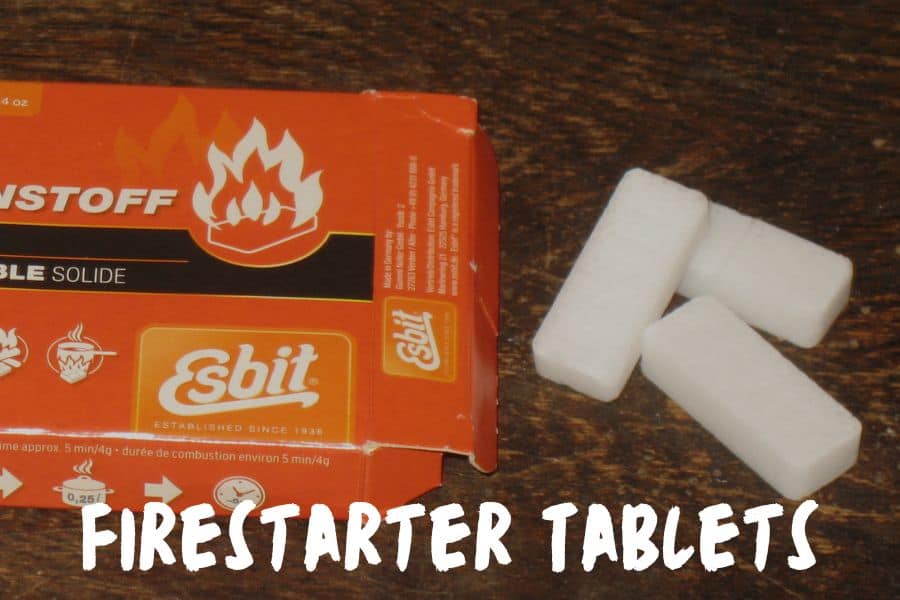
Firestarter tablets are generally made from hexamethylenetetramine, the combination of two chemicals called methenamine and hexamine.
While generally small in size, they will catch fire and burn for several minutes once lit.
These are a great option if you are car camping and are having trouble getting your fire started.
To start a fire, all the user needs to do is expose these tablets to sparks or flame.
Although fire starter tablets can be extremely convenient – and are sometimes included in survival packages – they should not be prioritized over the manual methods covered above for survival scenarios.
First, fire starter tablets can only be used once.
Not only are you creating waste that you will need to carry, but you are also limiting the amount of fires you’re able to build based on the number of tablets you bring.
Second, most fire starter tablets do not stand up well to moisture, so, even though they usually come in waterproof packaging, the tablets themselves are less reliable in wet weather scenarios.
Lighter Fluid
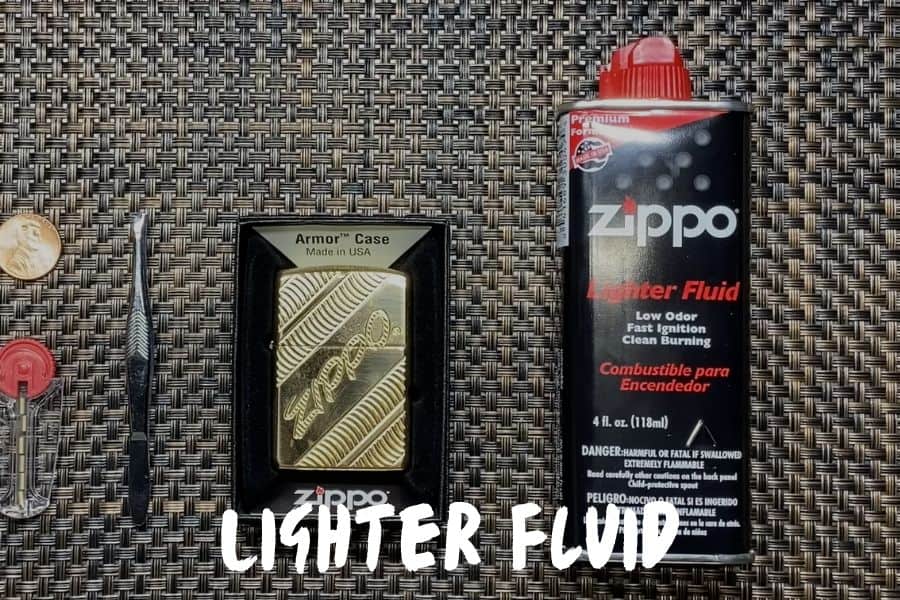
Lighter fluid is made from extremely flammable chemicals, including butane in its liquid form.
If you so choose, lighter fluid can be used to start a fire – and will work in any weather condition.
The best way to incorporate lighter fluid into your fire is to lightly pour it over the initial kindling. Then build your fire structure over that same kindling.
Once everything is ready to go, you can take a lighter or match and light one corner of the kindling on fire.
It’s important that the portion you choose is not doused in lighter fluid but will lead to a portion of the kindling that is.
It is extremely important to be careful when using lighter fluid as a fire starter. Adding too much can create large flame bursts that can harm you and those around you.
Additionally, anything that has lighter fluid on it will become flammable. Keep it off of your skin and make sure that you avoid getting it on any of your clothing, hair, and gear.
If you do get lighter fluid on any piece of clothing, do not wear that clothing around the fire pit.
Advantages Of Using A Chemical Fire Starter
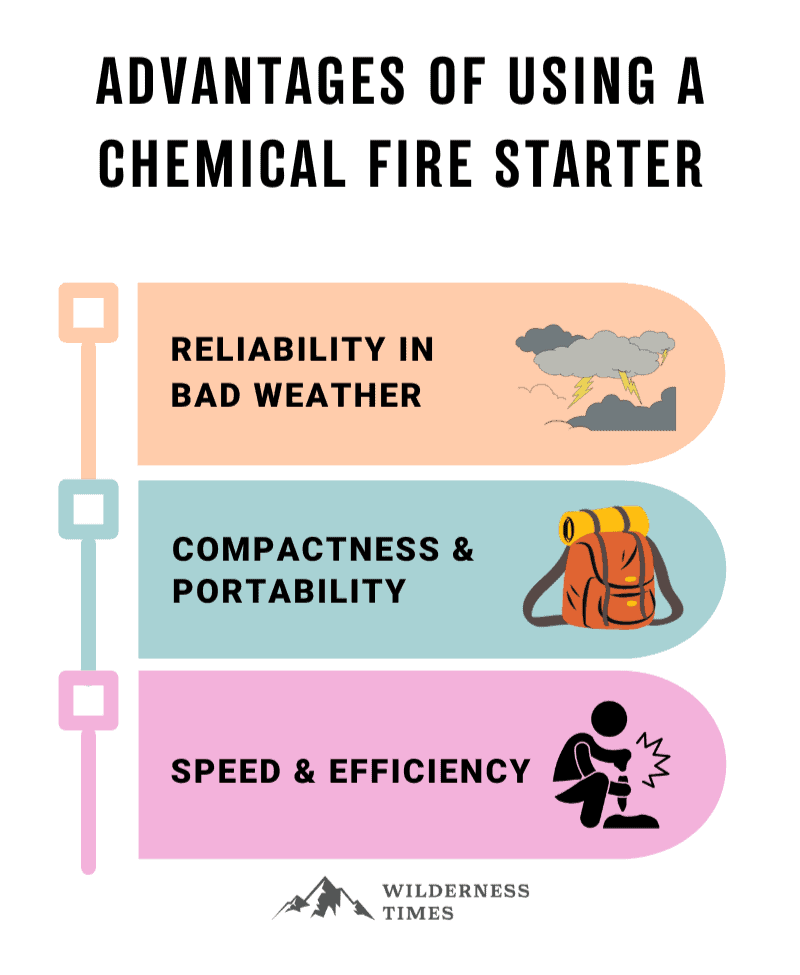
Both spark-based and chemical fire starters have advantages over the traditional, friction-based fire starting methods.
Reliability In Bad Weather
With the exception of fire starting tablets (chemical), spark-based and chemical fire starting techniques and tools will make it easy to build a successful fire – no matter the weather.
While it’s possible to create a fire using friction based methods, too much moisture in any part of your set-up can make it a difficult feat, even for the most experienced outdoors person.
In comparison, flint and steel, ferro rods, and lighter fluid are not negatively affected by moisture and will all reliably help you create a fire despite wet conditions.
Fire starting tablets can be a risk to bring in rainy or snowy weather because the tablets themselves are not always waterproof.
If their packaging rips and they get exposed to water, they may not work as reliably as other options.
Compactness & Portability
With the exception of lighter fluid, spark-based and chemical fire starters are extremely lightweight and compact. Because of this, they are great options for long treks and survival scenarios.
This is especially true for spark-based fire starters, like flint and steel and ferro rods, because they are lightweight, reusable, and dependable. Each spark-based fire starter can help you start multiple fires.
Speed & Efficiency
While both chemical and spark-based fire starters are more efficient than friction-based methods, chemical fire starts are by far the most efficient of the group.
This is because the chemicals in them will ignite if exposed briefly to flame or spark and stay lit, making the entire process quicker and easier for the user.
8 Fire Safety Tips You Need To Know About
Magnesium is highly flammable. When lit, it’s able to produce a fire that reaches temperatures of over 5000°F. That’s over twice as hot as a large bonfire!
While this makes it a brilliant tool for starting a fire, it also makes it incredibly dangerous. To avoid any disasters, make sure you brush up on your campfire safety knowledge before you go starting any fires.
Here are some things to keep in mind:
- Don’t light a fire in windy conditions.
- Make sure the species of wood you’re using is safe. The fumes of certain kinds of wood are a health hazard.
- Use a fire ring.
- Keep enough water to put the fire out close by in case of an emergency.
- Make sure your fire pit is larger than your fire.
- Make sure you’ve cleared the area around your fire.
- Make sure you’ve extinguished your fire properly before leaving the area.
- Don’t leave your campfire unattended!
FAQs
How Long Will The Average Fire Starter Last?
It depends. For the most part, chemical fire starters are either single use or, in the case of lighter fluid, have a finite amount of use depending on the size of lighter fluid container purchased.
Spark-based firestarters are going to last you a fairly long time. The average ferro rod can last anywhere from 8,000 to 12,000 strikes, while a flint rod can last up to 3,000 strikes.
Can I Use A Fire Starter In Wet Conditions?
It depends on what type of fire starter you’re using. Some firestarters, including flint and steel, ferro rods, and lighter fluid, will start a fire in wet conditions.
Friction-based methods can produce sparks in wet conditions but will have a lower success rate than the methods listed above.
Finally, fire starter tablets will not work if they get exposed to moisture or wet conditions.
Is Magnesium Better Than A Ferro Rod For A Fire Starter?
Ferro rods are going to be slightly more effective in starting fires than magnesium rods.
This is largely because they are made of a combination of metals, which create a large amount of sparks.
Ferro rods are also slightly more water-resistant than magnesium rods.
Are There Environmentally Friendly Fire Starters Available?
Sort of. If you’re looking for an environmentally friendly alternative to firestarter tablets, you will likely find eco-tablets that are made largely of condensed kindling.
While these can be effective, they will not be as effective as their chemical counterparts.
However, the friction and spark-based firestarter techniques are low impact and environmentally friendly approaches to creating a fire.
What’s The Difference Between A Fire Starter & A Lighter?
A fire starter is a device or technique that will create sparks that can be formed into a fire.
In comparison, a lighter is a piece of equipment that contains a portion of lighter fluid gas, as well as a sparking mechanism.
When the spark is exposed to the lighter fluid or gas, it creates a mini flame.
How Do I Store My Fire Starter When Not In Use?
When storing a spark-based or chemical fire starter, it’s best to find a cool, dry, dark space.
With chemical fire starters, you want to avoid any windows, wires, or heat sources that could be a potential fire risk while in storage.
Summary
So as you can see, it’s pretty simple. Prepare your fire pit, gather the wood, strike the flint, and blow.
That’s everything you need to know.
You’re all set to build a roaring fire next time you’re out camping, with the help of your trusty fire starter.
Just don’t forget the marshmallows!


